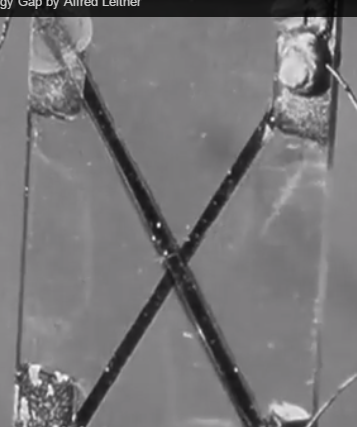In
all likelihood, we’ll go with a resistive measurement, (to detect the superconducting state or lack thereof), using a small lead
wire. The following setup is from an
Alfred Leitner video. We’ll use
something even simpler, probably just a lead wire with a four point probe
attached. By the way, if you're new to the game, scroll to the bottom for background information.
We
could sputter a line of lead onto a glass slide, but I don’t see the benefit
yet. Working on finding out what it is.
Check
this out later in the day per shaping samples:
I’m
performing the check on the resistance of the primary coil as its cooled by
liquid nitrogen. The idea is that
yesterday’s increase in output ignal with the superconductor ooled may have
noly been do to the primary pulling more current as its resistance ramped
down. Here are a few pictures of the
assembly being taken apart for the present work:
|
|
A
one ohm resistor has been placed in series with the primary coil. The readout across the resistor is
proportional to the current through the circuit. The resistor signal is the smaller signal in
the following picture.
The
basic lesson of the day was not to build coils that can move in any possible way. The second attempt to check for reduced
resistance, (which should happen), had contradictory results. The first and final attempts returned the
expected results, but they’re not reliable given the first two runs. The available data follows.
First
attempt:
Room
temp:
Post-cooling
with liquid nitrogen:
Second Experiment:
Pre-cooling:
Post-cooling:
This
is also where it was observed that the oscillator has a significant phase
shift.
Third
experiment:
pre-cooling:
post-cooling:
Background
Hirsch's theory of hole superconductivity proposes a new
BCS-compatible model of Cooper pair formation when superconducting materials
phase transition from their normal to their superconducting state[1]. One
of the experimentally verifiable predictions of his theory is that when a
superconductor rapidly transitions, (quenches), back to its normal state, it
will emit x-rays, (colloquially referred to here as H-rays because it's
Hirsch's theory).
A superconductor can be rapidly transitioned back to its normal state by placing it in a strong magnetic field. My experiment will look for H-rays emitted by both a Pb and a YBCO superconductor when it is quenched by a strong magnetic field.
A superconductor can be rapidly transitioned back to its normal state by placing it in a strong magnetic field. My experiment will look for H-rays emitted by both a Pb and a YBCO superconductor when it is quenched by a strong magnetic field.
This series of articles chronicles both the experimental lab
work and the theory work that’s going into completing the experiment.
The lab book entries in this series detail the preparation and execution of this experiment… mostly. I also have a few theory projects involving special relativity and quantum field theory. Occasionally, they appear in these pages.
The lab book entries in this series detail the preparation and execution of this experiment… mostly. I also have a few theory projects involving special relativity and quantum field theory. Occasionally, they appear in these pages.
Call for Input
If you have any ideas, questions, or comments, they're very
welcome!
References
1. Hirsch, J. E.,
“Pair production and ionizing radiation from superconductors”, http://arxiv.org/abs/cond-mat/0508529










Comments
Post a Comment
Please leave your comments on this topic: